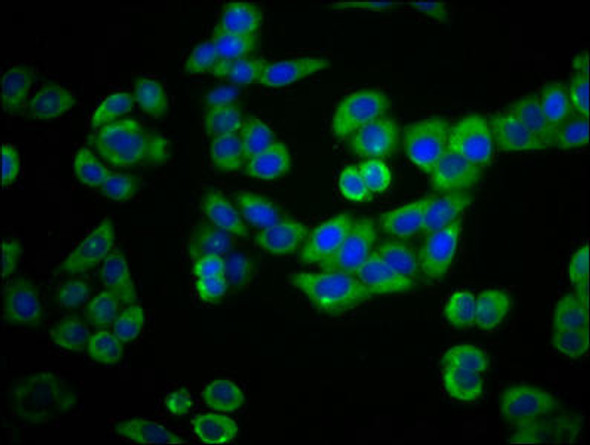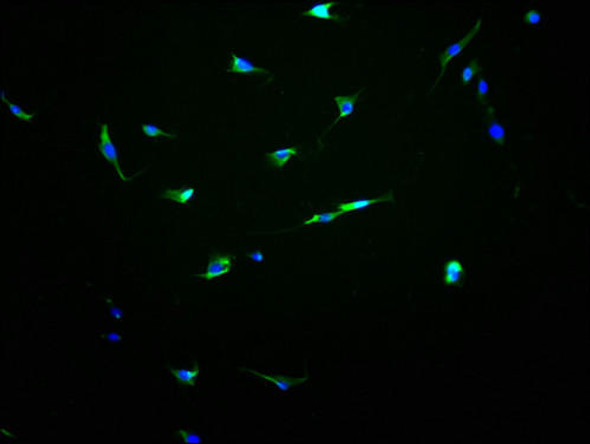Description
| Antibody Name: | PLEKHG5 Antibody (PACO11300) |
| Antibody SKU: | PACO11300 |
| Size: | 50ul |
| Host Species: | Rabbit |
| Tested Applications: | ELISA, WB |
| Recommended Dilutions: | |
| Species Reactivity: | Human, Mouse, Rat |
| Immunogen: | Human PLEKHG5 |
| Form: | Liquid |
| Storage Buffer: | PBS with 0.02% Sodium Azide, 50% Glycerol, pH 7.3. -20°C, Avoid freeze / thaw cycles. |
| Purification Method: | Antigen Affinity purified |
| Clonality: | Polyclonal |
| Isotype: | IgG |
| Conjugate: | Non-conjugated |
| Synonyms: | pleckstrin homology domain containing, family G (with RhoGef domain) member 5;PLEKHG5;DSMA4;GEF720;KIAA0720;RP4-650H14.3 ; |
| UniProt Protein Function: | PLEKHG5: Activates the NF-kappa-B signaling pathway and RHOA. Appears to be involved in the control of neuronal cell differentiation. Defects in PLEKHG5 are the cause of distal spinal muscular atrophy autosomal recessive type 4 (DSMA4). Distal spinal muscular atrophy, also known as distal hereditary motor neuronopathy, represents a heterogeneous group of neuromuscular disorders caused by selective degeneration of motor neurons in the anterior horn of the spinal cord, without sensory deficit in the posterior horn. The overall clinical picture consists of a classical distal muscular atrophy syndrome in the legs without clinical sensory loss. The disease starts with weakness and wasting of distal muscles of the anterior tibial and peroneal compartments of the legs. Later on, weakness and atrophy may expand to the proximal muscles of the lower limbs and/or to the distal upper limbs. DSMA4 is characterized by childhood onset, generalized muscle weakness and atrophy with denervation and normal sensation. Bulbar symptoms and pyramidal signs are absent. 5 isoforms of the human protein are produced by alternative splicing.Chromosomal Location of Human Ortholog: 1p36.31Cellular Component: cytoplasm; cytosol; endocytic vesicle; intercellular junction; lamellipodiumMolecular Function: guanyl-nucleotide exchange factor activity; Rho guanyl-nucleotide exchange factor activity; signal transducer activityBiological Process: positive regulation of apoptosis; positive regulation of I-kappaB kinase/NF-kappaB cascade; regulation of small GTPase mediated signal transductionDisease: Charcot-marie-tooth Disease, Recessive Intermediate C; Spinal Muscular Atrophy, Distal, Autosomal Recessive, 4 |
| UniProt Protein Details: | |
| NCBI Summary: | This gene encodes a protein that activates the nuclear factor kappa B (NFKB1) signaling pathway. Mutations in this gene are associated with autosomal recessive distal spinal muscular atrophy. Multiple transcript variants encoding different isoforms have been found for this gene. [provided by RefSeq, May 2012] |
| UniProt Code: | O94827 |
| NCBI GenInfo Identifier: | 160014162 |
| NCBI Gene ID: | 57449 |
| NCBI Accession: | O94827.3 |
| UniProt Secondary Accession: | O94827,Q5SY17, Q5T8W5, Q5T8W9, Q6ZNM0, Q7Z436, Q86YD8 B3KU07, B7Z2M3, B7Z5X2 |
| UniProt Related Accession: | O94827 |
| Molecular Weight: | 118,479 Da |
| NCBI Full Name: | Pleckstrin homology domain-containing family G member 5 |
| NCBI Synonym Full Names: | pleckstrin homology and RhoGEF domain containing G5 |
| NCBI Official Symbol: | PLEKHG5 |
| NCBI Official Synonym Symbols: | Syx; Tech; DSMA4; CMTRIC; GEF720 |
| NCBI Protein Information: | pleckstrin homology domain-containing family G member 5 |
| UniProt Protein Name: | Pleckstrin homology domain-containing family G member 5 |
| UniProt Synonym Protein Names: | Guanine nucleotide exchange factor 720; GEF720 |
| Protein Family: | Pleckstrin homology domain-containing family |
| UniProt Gene Name: | PLEKHG5 |
| UniProt Entry Name: | PKHG5_HUMAN |






